The Northern Saw-whet Owl (Aegolius acadicus) stands as a diminutive yet captivating resident of North American forests, captivating bird enthusiasts with its distinctive features and elusive nature.
Sporting a compact frame, rounded head, and prominent facial disc, this small owl species measures around 7 to 8 inches in length.
With bright yellow eyes that contribute to its expressive countenance, the Northern Saw-whet Owl is a nocturnal marvel, exhibiting remarkable vocalizations reminiscent of a saw being sharpened.
Its preferred habitats include coniferous and mixed forests, where it adeptly navigates dense vegetation during daylight hours.
Despite its small size, this owl is an effective predator, preying on small mammals, birds, insects, and even amphibians or reptiles. Exploring the life history, behavior, and conservation status of the Northern Saw-whet Owl. Stay focused.
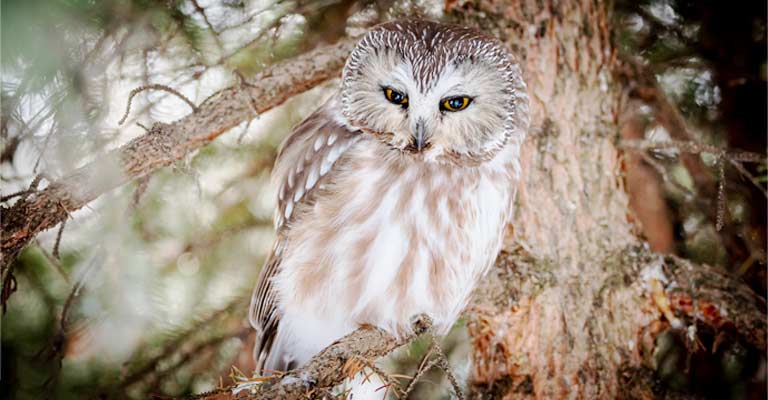
Physical Characteristics of Northern Saw-whet Owl
The Northern Saw-whet Owl (Aegolius acadicus) is a small owl species that inhabits the forests of North America.
Despite its diminutive size, ranging from 7 to 8 inches in length, this owl possesses distinctive physical characteristics that make it easily identifiable.
Here are some key points to help identify the Northern Saw-whet Owl:
Size and Appearance

The Northern Saw-whet Owl is one of the smallest owls in North America. Its compact size, rounded head, and short tail contribute to its distinctive appearance.
The plumage varies in color, typically featuring a mix of brown, white, and rust-colored feathers. The facial disc is well-defined, and the eyes are large and yellow.
Facial Features
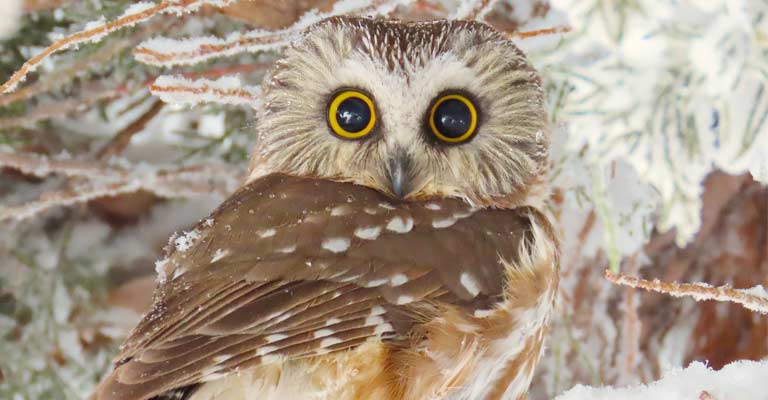
The facial disc of the Northern Saw-whet Owl is a crucial identifying feature.
The facial disc is framed by a border of fine, dark feathers, creating a distinctive “frame” around the owl’s face. The disc aids in funneling sound to its ears, assisting in its exceptional hearing abilities.
Eye Color
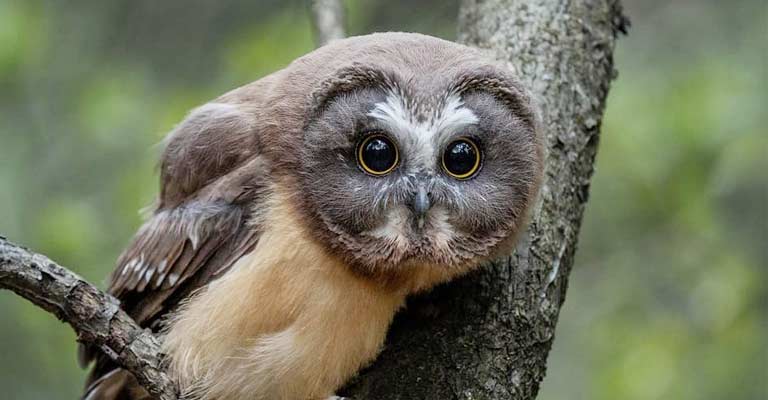
The bright yellow eyes of the Northern Saw-whet Owl are another characteristic feature.
These striking eyes stand out against the owl’s muted plumage and contribute to its overall charming and expressive appearance.
Bill and Talons
The owl’s bill is short and hooked, adapted for capturing and consuming small prey such as mice and insects. The talons are sharp and powerful, reflecting its carnivorous nature.
The combination of a hooked bill and strong talons is common among raptors, allowing for efficient hunting.
Size Discrepancy between Genders
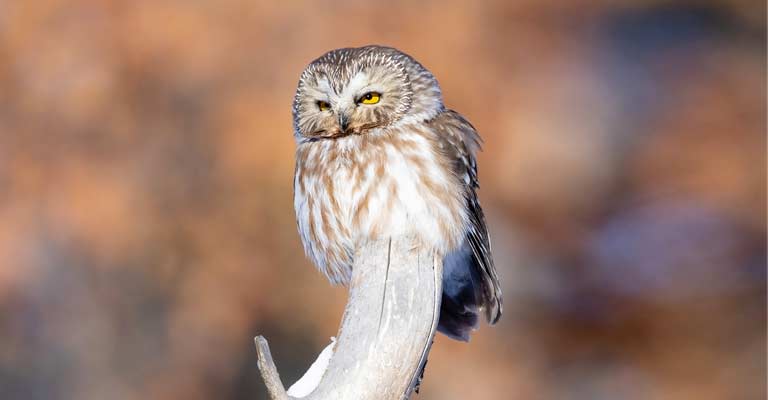
In many owl species, there is a size discrepancy between males and females. In the Northern Saw-whet Owl, females are generally larger than males.
Observing multiple individuals or comparing the size of an owl to its surroundings can provide clues about its gender.
Cryptic Behavior
Northern Saw-whet Owls are known for their cryptic behavior, often perching in dense vegetation or low branches.
Their reliance on camouflage makes them challenging to spot, and their presence is often revealed by their distinctive vocalizations rather than visual identification.
Vocalizations
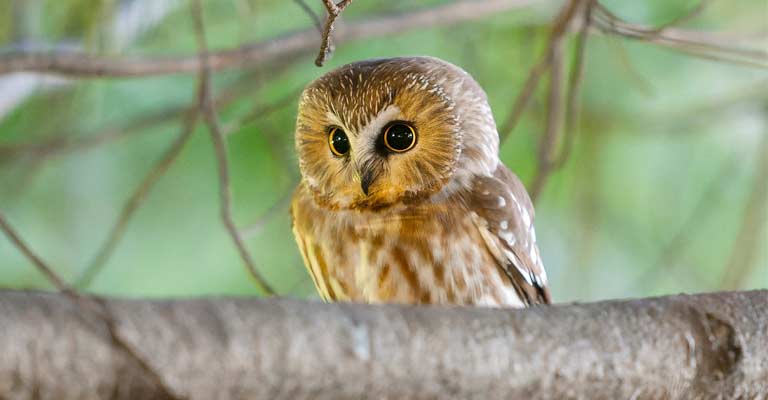
Identifying the Northern Saw-whet Owl can also involve recognizing its unique vocalizations.
The owl produces a repetitive, high-pitched tooting sound that has been likened to the noise made by a saw being sharpened, hence the name “saw-whet.”
Habitat and Range
Understanding the owl’s preferred habitat can aid in identification. Northern Saw-whet Owls are typically found in coniferous and mixed forests across North America.
Their range extends from Alaska and Canada to the northern United States, making them well-adapted to diverse woodland environments.
The Northern Saw-whet Owl’s small size, distinctive facial features, eye color, bill and talon morphology, gender-based size differences, cryptic behavior, vocalizations, and habitat preferences are key factors in identifying this charming and elusive owl species in the wild.
Taxonomical of Northern Saw-whet Owl
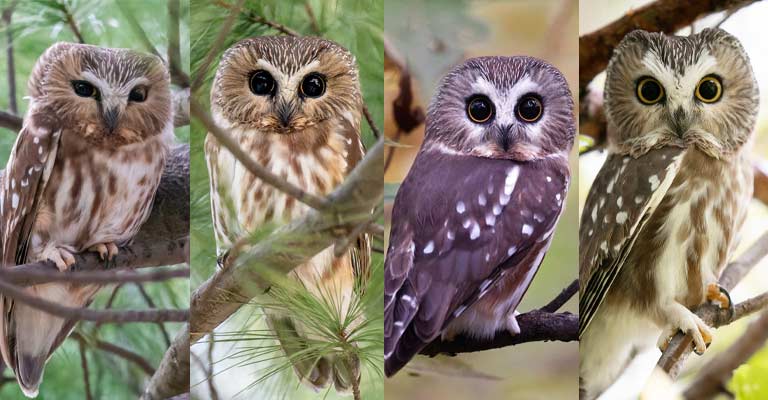
Here is a proper table summarizing the taxonomy details of the Northern Saw-whet Owl:
| Taxonomic Rank | Classification |
| Domain | Eukaryota |
| Kingdom | Animalia |
| Phylum | Chordata |
| Class | Aves |
| Order | Strigiformes |
| Family | Strigidae |
| Genus | Aegolius |
| Species | A. acadicus |
The Northern Saw-whet Owl (Aegolius acadicus) belongs to the family Strigidae, which encompasses various owl species globally.
Within the genus Aegolius, the Northern Saw-whet Owl is specifically classified under the species Aegolius acadicus.
This small, nocturnal owl is widely distributed across North America, with a range extending from Alaska and Canada to the northern United States.
Known for its distinct appearance, including a rounded head, facial disc, and striking yellow eyes, the Northern Saw-whet Owl plays a vital role in maintaining ecological balance through its predation on small mammals and insects within its woodland habitats.
Common Food of Northern Saw-whet Owl
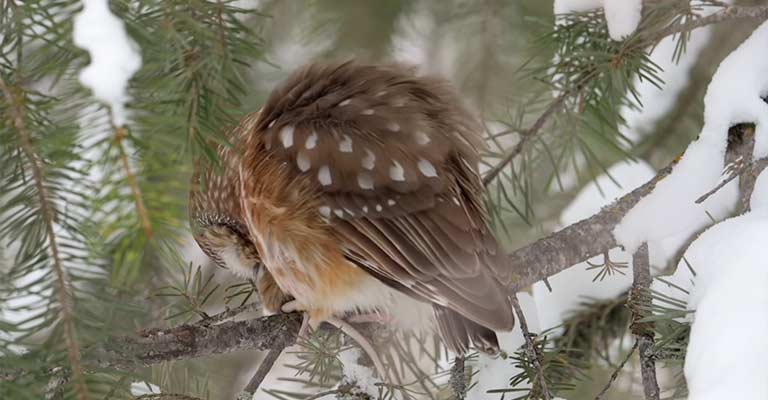
The Northern Saw-whet Owl (Aegolius acadicus) is a carnivorous bird with a diet primarily consisting of small mammals and insects.
Despite its small size, this owl is an adept hunter, relying on its keen vision and exceptional hearing to locate prey. The common foods in the Northern Saw-whet Owl’s diet include:
- Mice and Voles: These small rodents are a staple in the diet of Northern Saw-whet Owls. The owls use their sharp talons and hooked bills to capture and consume these elusive mammals.
- Birds: Occasionally, Northern Saw-whet Owls may prey on small birds, particularly during times when rodent populations are scarce.
- Insects: Insects, such as beetles and moths, also make up a portion of their diet, especially during the warmer months when these prey items are more abundant.
- Amphibians and Reptiles: On occasion, Northern Saw-whet Owls may consume small amphibians or reptiles, broadening their diet based on seasonal availability.
Their diverse diet reflects the adaptability of the Northern Saw-whet Owl, allowing it to thrive in a variety of woodland environments where these prey items are abundant.
Habitation and Range Map of Northern Saw-whet Owl
The Northern Saw-whet Owl (Aegolius acadicus) inhabits a broad range across North America, exhibiting a preference for coniferous and mixed forests.
These adaptable owls can be found in various woodland environments, including boreal forests, mountainous regions, and even wooded suburban areas.
Range Map
The range map of the Northern Saw-whet Owl encompasses extensive portions of North America, from Alaska and Canada to the northern United States.
The boreal forests of Canada, characterized by dense stands of coniferous trees, are particularly favorable habitats for the Northern Saw-whet Owl.
This species is well-adapted to the challenging conditions of these northern forests, where it can utilize the cover provided by evergreen trees for roosting and nesting.
Additionally, the range extends into the northern United States, covering areas with suitable woodland habitats.
Habitation
The presence of the Northern Saw-whet Owl in mountainous regions highlights its ability to thrive in diverse elevations, from lowlands to higher altitudes.
The range map also reflects the migratory behavior of some Northern Saw-whet Owls.
While some individuals are year-round residents in their breeding territories, others may migrate southward during winter, particularly when prey availability decreases in the colder months.
Northern Saw-whet Owl Life History
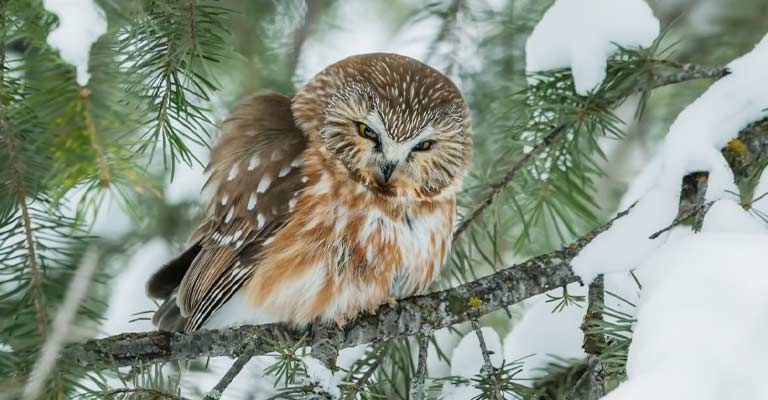
The Northern Saw-whet Owl (Aegolius acadicus) is a fascinating small owl species with a distinctive appearance and a rich life history.
This elusive bird, found across North America, exhibits unique behaviors, intricate hunting strategies, and a well-defined life cycle.
Exploring the life history of the Northern Saw-whet Owl provides insights into its survival strategies, breeding habits, and the conservation challenges it faces.
Behavior
Northern Saw-whet Owls are primarily nocturnal, meaning they are most active during the night. They are known for their cryptic behavior, perching in dense vegetation during the day to avoid detection.
These owls have excellent hearing, aided by their facial discs that funnel sound to their ears, making them efficient nocturnal hunters.
Hunting
Hunting primarily at night, Northern Saw-whet Owls prey on small mammals such as mice and voles, employing silent flight and sharp talons for effective capture.
Their keen vision and exceptional hearing contribute to their success as predators. They occasionally consume small birds, insects, and even amphibians or reptiles, showcasing their adaptability.
Nesting
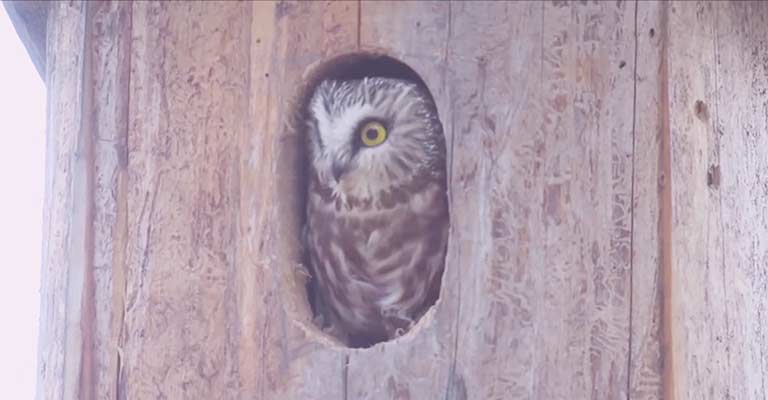
Nesting typically occurs in tree cavities, abandoned woodpecker holes, or nesting boxes. The female lays a clutch of eggs, and both parents share the responsibilities of incubation and caring for the chicks.
Nesting sites are chosen strategically to provide shelter and protection for the vulnerable young owlets.
| Nesting Details | Facts |
| Clutch Size | 3 to 7 eggs |
| Number of Broods | Typically 1 per breeding season |
| Egg Length | Approximately 1.2 inches (3 cm) |
| Egg Width | Approximately 1 inch (2.5 cm) |
| Incubation Period | Around 21 to 28 days |
| Nestling Period | Approximately 27 to 38 days |
| Egg Description | White or lightly colored with a smooth surface |
| Nesting Location | Elevated sites in forests, typically in coniferous trees |
| Parental Involvement | Both parents share incubation |
| Nest Defense | Adults may defend nesting site |
| Nesting Season | Late winter to early spring for breeding |
| Territorial Behavior | Exhibits territorial behavior during the breeding season |
Understanding the nesting details of the Northern Saw-whet Owl provides valuable insights into their reproductive biology and contributes to conservation efforts by identifying key factors for successful breeding.
Breeding
Breeding season for Northern Saw-whet Owls generally begins in late winter or early spring. Males attract females with vocalizations, and pairs form for the breeding season.
The species may exhibit territorial behavior during this time, defending their nesting sites from potential threats.
Diseases
Like many bird species, Northern Saw-whet Owls can be susceptible to various diseases, including avian malaria and West Nile virus.
These diseases can impact their health and survival, posing challenges to their populations.
Treatment
The treatment of diseases in Northern Saw-whet Owls often involves rehabilitation efforts by wildlife rehabilitators and veterinarians.
Prompt diagnosis, supportive care, and appropriate treatment strategies are crucial for the successful recovery and release of affected individuals back into their natural habitat.
Conservation
Conservation efforts for Northern Saw-whet Owls focus on preserving their habitat, raising awareness about the importance of these birds in maintaining ecological balance, and mitigating threats such as habitat loss.
Monitoring and research programs contribute valuable data for understanding population trends and informing conservation strategies to ensure the long-term survival of this enchanting owl species.
5 Fun Facts About Northern Saw-whet Owl
The Northern Saw-whet Owl (Aegolius acadicus) may be small in stature, but it boasts a fascinating array of characteristics that captivate bird enthusiasts.
Here are five fun facts that shed light on the unique traits of this charming owl species.
- Mimicry Masters: Northern Saw-whet Owls are skilled mimics, often imitating the calls of other birds. This behavior serves multiple purposes, from luring potential prey closer to revealing their presence to observant birders.
- Incredible Hearing: With facial discs that funnel sound and asymmetrical ear placements, these owls possess exceptional hearing. This keen sense aids them in locating prey in the dark, ensuring successful nocturnal hunts.
- Nomadic Migrations: Some Northern Saw-whet Owls exhibit nomadic tendencies, undertaking irregular migrations in search of food. This behavior adds an element of unpredictability to their movements and habitats.
- Tiny Talons, Big Appetite: Despite their small size, Northern Saw-whet Owls have powerful talons capable of subduing prey larger than themselves. They primarily feed on small mammals but are versatile hunters.
- Monogamous Pairs: These owls engage in monogamous relationships during the breeding season, with pairs forming to raise their young. Both parents actively participate in incubation, nest defense, and the subsequent care of their adorable owlets.
Wrapping Up
In the enchanting world of the Northern Saw-whet Owl, we uncover a tapestry of behaviors, from their adept hunting strategies to the intricacies of nesting and breeding.
These small yet charismatic owls, with their unique vocalizations, mimicry skills, and nomadic tendencies, showcase the remarkable adaptability of wildlife.
As we delve into their life history and conservation challenges, it becomes clear that the Northern Saw-whet Owl is not just a bird; it’s a captivating ambassador for the delicate ecosystems it inhabits.
Understanding and appreciating these fascinating creatures not only deepens our connection to nature but also underscores the importance of preserving their habitats for generations to come. Thank you so much.